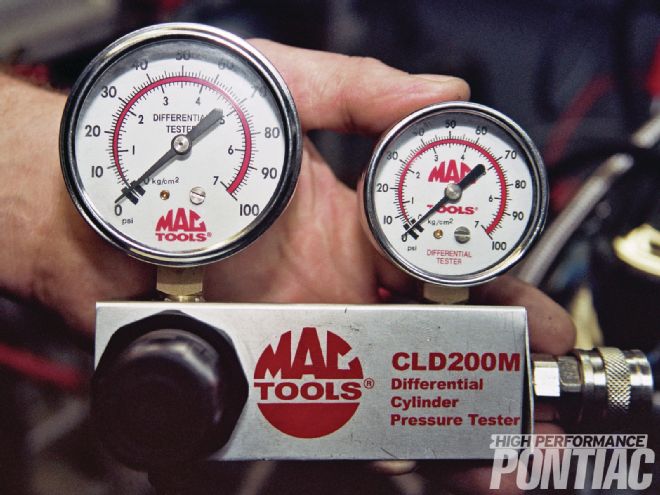
With every passing day the Mule provides opportunities beyond our original expectations. Since the 467ci engine belongs to HPP editor Tom DeMauro, it is at our beck and call. This affords HPP the ability to do things, such as our octane test, that would not be possible with a third party engine. (Try telling the owner of a nearly 500hp Poncho that you want to dyno it on regular grade gasoline and see how far you get!) So far we have tested three different grades of fuel, a similar amount of oil viscosities, and a mix of rocker arm ratios beyond the original dyno testing and tuning.
At this point, the Mule has well over 100 full-power, full-throttle runs, not counting other partial pulls. Moving forward we’re planning more testing.
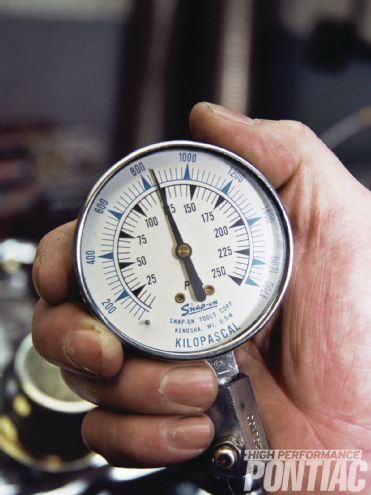
With all of this stress on Project Pure Poncho, both the author and RaceKrafters thought it would be a good time to perform a cursory check-up of its health. No, we were not going to pull it apart, but instead perform an automotive version of a CT scan or X-ray. Compression and leakdown tests allow the health of the engine to be quantified without any more effort than removing the spark plugs. In addition, we introduce a procedure identified as a bubble test that many may not be familiar with.
Under the Microscope
The best way for any enthusiast to keep track of their engine’s health is to perform routine testing and document the results. This way, as time or use accumulates, you can accurately track the internal condition of the Pontiac engine, not only as a confirmation of all being well but as a trigger to locate a potential issue before it becomes a major problem. There is no better method for this than compression and leakdown tests. Since each has it own value and protocols, they will be discussed separately.
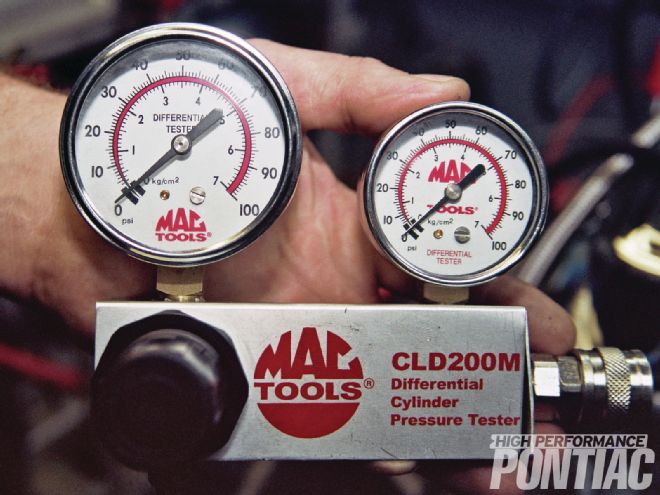 1 We did the leakdown test first before the engine got hot. We did not want to wait for it to cool off after the running tests.
1 We did the leakdown test first before the engine got hot. We did not want to wait for it to cool off after the running tests.
Compression Tests
When discussing a compression test, the question always comes up about how the results are indicative of the engine’s compression ratio. The blunt answer is they are not. It is apples and oranges.
The compression ratio is the difference in cylinder volume with the piston at top dead center (TDC) versus the volume with it at bottom dead center (BDC). For example, if the volume at BDC is 10-times greater than the volume at TDC, the engine has a 10:1 compression ratio (CR).
CR impacts an engine’s thermal efficiency ( “Eating Crow,” Sept. ’12), throttle response, and output for both torque and horsepower along with its octane appetite. Though it is well documented that the CR has a direct impact on thermal efficiency, the engine’s octane requirement can be lowered by design protocols, such as high rates of mixture motion, spark plug location to the bore center, and combustion chamber design. That is how so many newer engines can employ a 12:1 CR on 87-octane gasoline without experiencing abnormal combustion.
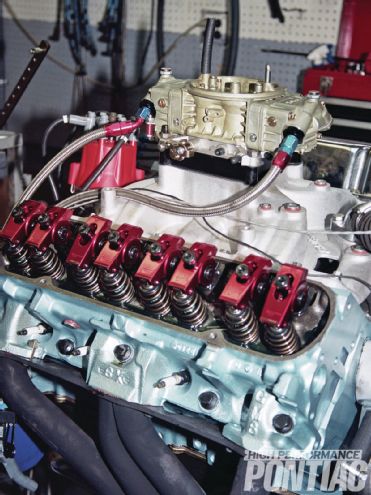 2 Craig pulled the valve covers off so he could visually check the valvetrain.
2 Craig pulled the valve covers off so he could visually check the valvetrain.
The compression test establishes the engine’s ability to pump air and build cylinder pressure in the bore. It checks the sealing of the cylinder under pressure and the piston rings’ ability to keep the compression gases working against the piston crown instead of escaping into the oil pan. It also is an indicator of the ability of the valve to seal against the seat and make an airtight bore.
Most are familiar with a traditional cranking compression test, but there is also a running compression test that is very important. We performed both on the Mule.
The readings are measured in pounds of pressure per square inch.
Leakdown Test
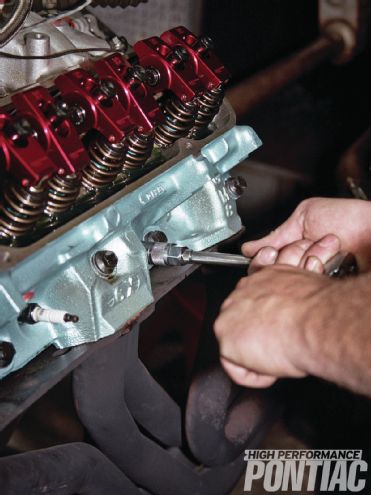 3 It is best to remove all of the spark plugs to make it easier to turn the crankshaft.
3 It is best to remove all of the spark plugs to make it easier to turn the crankshaft.
While the compression test is dynamic (the piston is moving), the leakdown has the piston static (not moving). Instead of the piston building pressure in the bore by moving up and down, the leakdown test applies shop (compressed) air to the cylinder while determining the amount that exits. The leakdown test is read as a percentage of total cylinder pressure inputted. It is a differential test.
The standard protocol is to fill the cylinder with 100 psi of air and then measure the loss. If 94 percent of the pressure remains, the cylinder is said to have 6 percent leakage.
There are leakdown testers that have one gauge, while the preferred design has two gauges—one for the line pressure and the other for the differential. Regardless of the style, a leakdown test is a valuable tool that needs to be recognized.
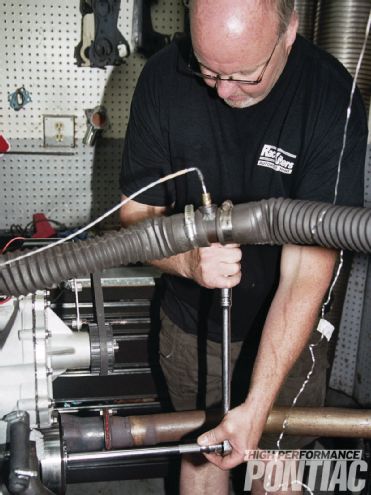 4 You need to have each cylinder tested for leakage on TDC. Don’t be alarmed if the piston moves the crank once the air pressure is applied, especially with the plugs out. If it does turn the crank, you may need to get the piston right on the dwell period so that it does not move.
4 You need to have each cylinder tested for leakage on TDC. Don’t be alarmed if the piston moves the crank once the air pressure is applied, especially with the plugs out. If it does turn the crank, you may need to get the piston right on the dwell period so that it does not move.
Bubble Test
This test is used to determine the health of a head gasket in the region between two cylinder bores. There are occasions when either a compression or leakdown test does not show a minor leak between the cylinder sealing surfaces. It’s performed by applying 100 psi of air pressure into a bore, and placing the hose from a compression or leakdown tester in the adjacent cylinder’s spark plug hole with one end in a can of water. If there any sealing issues, bubbles will be seen in the water. To be accurate, it should be done with each cylinder pressurized, since there may be an occasion where the gasket leaks only in one direction. Though this condition is rare, it must to be understood that the purpose is to diagnose a problem and no assumptions or short cuts can be taken.
There is no pressure reading with the bubble test, only a visual confirmation of air in the water in the can or pail.
There are two other tests that are also very valuable but were not performed on our engine. These are a vacuum test and oil analysis.
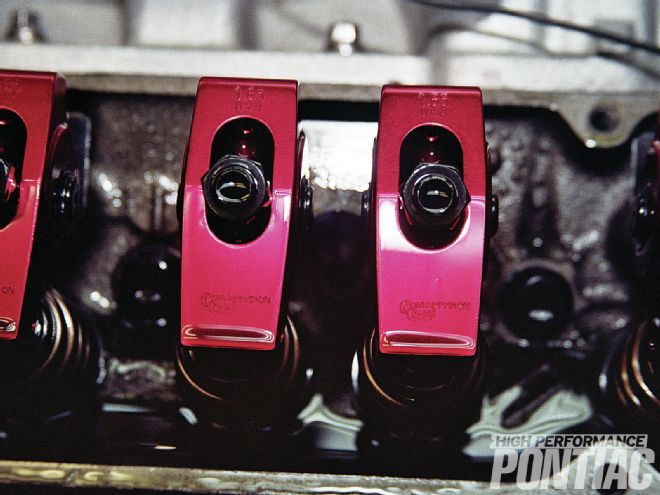 5 It is not essential to pull off the valve covers, but it does make it easier to confirm TDC on each cylinder by watching the rockers to ensure both valves are closed, especially if you have an unmarked balancer.
5 It is not essential to pull off the valve covers, but it does make it easier to confirm TDC on each cylinder by watching the rockers to ensure both valves are closed, especially if you have an unmarked balancer.
Oil Analysis
Oil analysis is an excellent method to see if any excessive wear is taking place inside the Pontiac engine. In almost every instance it identifies the exact component. This is done by determining the amount and type of material in the oil.
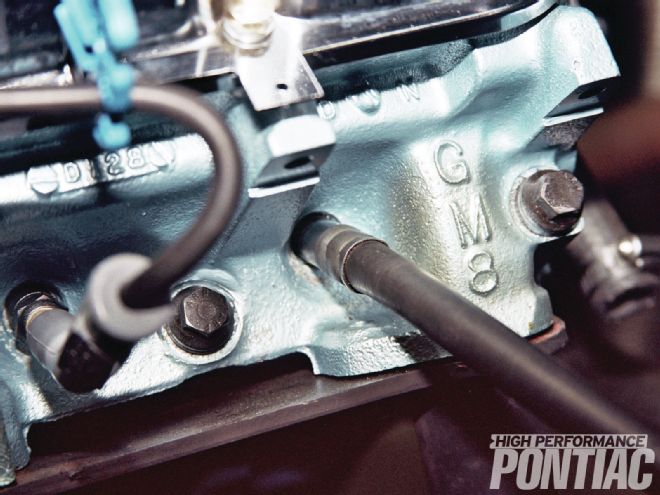 6 The leakdown tester has a special hose that goes from the tool into the spark plug hole.
6 The leakdown tester has a special hose that goes from the tool into the spark plug hole.
Anti-freeze, cylinder bore wear along with bearing, valve parts, and almost anything else that comes in contact with the engine oil can tell a story. In addition, fuel dilution and the viscosity of the oil can be determined.
The reason we did not do an oil analysis on The Mule is that for it to be accurate the lubricant needs to have been in use for a while. Our previous session was establishing the impact of the varied grades of Brad Penn oil. The lubricant in the oil pan had only four or five runs on it. Not enough time to determine anything.
Oil analysis is performed by taking a sample in a clean container and sending it to a laboratory for review. Often the laboratory will supply a container of their choice. Only a few ounces of oil are required. The oil pan does not need to be dumped to get an accurate analysis. This is an extremely valuable tool to determine the health and history of an engine, especially in a Pontiac that you are considering buying.
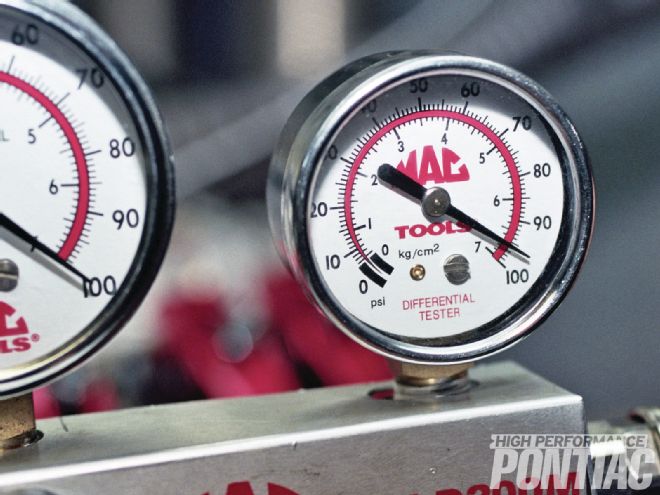 7 With a two-gauge system you read the differential. We inputted 100 psi in to the cylinder and the other gauge read 94. You then subtract the two to come up with 6 percent leakage.
7 With a two-gauge system you read the differential. We inputted 100 psi in to the cylinder and the other gauge read 94. You then subtract the two to come up with 6 percent leakage.
Vacuum Test
The vacuum test is a very useful measure for defined diagnostics.
It is very easy to perform, since it only needs to be connected to a manifold (full-time) vacuum port on the engine. It can determine late camshaft or ignition timing (low vacuum signal) a burned valve (rapidly shaking needle) or an exhaust restriction (vacuum decreases from idle to 2,500 rpm).
None of those areas were a problem in our engine so the testing would have proved of no value. This test should be performed first on a street Pontiac with an engine or running problem.
Proper Execution
As with any test protocol there needs to be a logical approach and a determination of when to do each type.
The traditional cranking compression test is the first to be called upon for a poor running engine that has no ignition or fuel system problem. If the engine is in such bad shape that a running or idle problem is present, you will usually find it with a cranking compression test.
If the results of the cranking compression test are inconclusive, a running compression test should be performed. With this procedure you ground the spark plug wire on the test bore and take a compression reading with the engine idling.
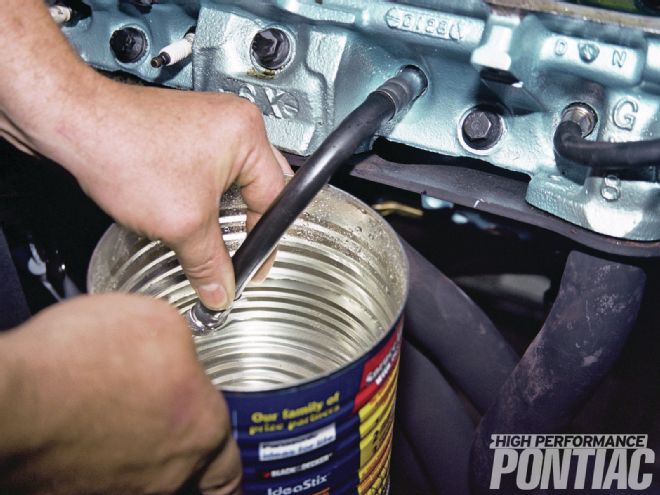 8 The bubble test is simple and can detect a poor seal between the cylinders that is not leaking water but cylinder pressure.
8 The bubble test is simple and can detect a poor seal between the cylinders that is not leaking water but cylinder pressure.
In some instances, a loose or pinched/cracked ring or a valve that is not sealing properly or is slow to return, may be masked by the slow speed of the engine while cranking. And as with any test procedure, error can be introduced if not done correctly or as in many cases sloppily.
To perform an accurate cranking compression test, do the following:
• Remove all spark plugs from the engine
• Connect a booster-style charger to the battery to maintain cranking speed
• Pin or hold the throttle wide-open (make sure the choke is open)
• Crank the engine over five pulses of the gauge
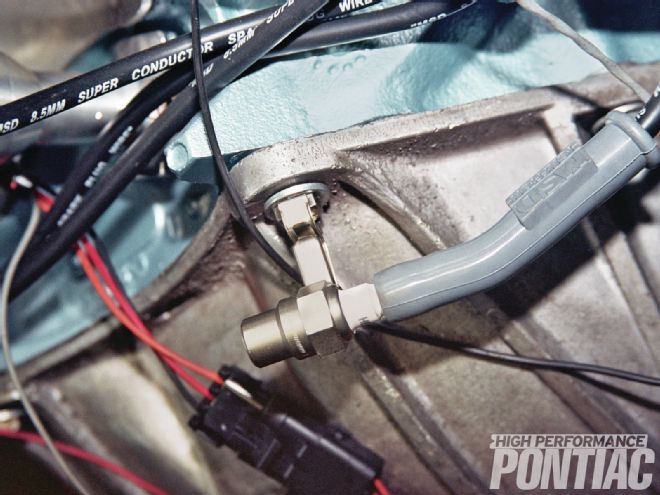 9 When doing a running compression test, make sure you ground the spark plug wire for that cylinder or use a tester. You do not want the electricity arcing in the distributor cap.
9 When doing a running compression test, make sure you ground the spark plug wire for that cylinder or use a tester. You do not want the electricity arcing in the distributor cap.
There is debate as to whether a cranking compression test should be performed with the engine hot or cold. As the author, I do not feel that it makes a difference as long as all of the cylinders are tested with approximately the same temperature. You would not want to start the test with the engine hot and then come back the next day and finish with it cold. In theory, the temperature should not make much of a difference if the engine is sound. And if there is a major problem you will see it anyway.
Another trick that some like to do on a cylinder with low compression is to squirt a little oil in the bore and if the reading comes up, the rings/bore are worn. There is value to that in eliminating the valves as a source of sealing. But if you have a leakdown tester, I believe that would be more accurate than some oil. There is always the possibility the oil does not seal the bore completely.
It must be understood that these are only tests to locate a problem area and are not conclusive. If you determine that compression is very low on one cylinder, the engine has to come apart. It makes little difference then if it is the ring or the cylinder wall because it will need to be over-bored anyway and new parts fitted. Many get into deep predictions of what is wrong. For the most part, it is akin to predicting the weather six months from now—you have an equal chance of being right or wrong.
If the cranking compression test proves inconclusive, then do a running compression test. The only stipulation with a running test is that you only idle the engine. You do not want excessive upward motion on the piston without an expanding flame on the top. You do not want to check the running compression at 3,500 rpm for example. But idling is no problem.
The cylinder leakdown test is used to find why a Pontiac engine is down slightly on performance. Let’s say your car always ran 12.50 at the track but over the years it has slowed down to 12.80. Other than that it runs fine. You do a cranking and running compression test and all looks good.
The next step would be a leakdown test. If the cylinder is not sealing properly, the engine will lose power. A leakdown test should be performed with the piston at TDC for that bore with confirmation that both valves are closed. You simply read the tool and determine the leak rate.
Some like to do a leakdown at TDC and then at BDC to see if there is taper in the bore. Again, in almost every instance if the cylinder is sealing poorly you will see it at TDC. You are looking for the lost horsepower and the amount of taper in the bore is moot if the engine is going to come apart.
The important thing about a leakdown test is that all cylinder leakage does not occur past the rings. If the leak value is high, you need to listen for where the air is going. If the air is entering the oil pan (by listening through the dipstick hole), then the rings or cylinder wall is the problem. Air escaping from the carburetor is an intake valve. If the noise is heard at the tailpipe, it is an exhaust valve. This is why the leakdown test is a complement to the compression test. It determines the actual location of the leakage.
Returning to our example of a Pontiac that has lost 0.3 at the track, if the owner had data from when the car ran 12.50s, then he would immediately be able to locate why the Pontiac has slowed down.
The compression and leakdown tests should also be performed before any major modifications are planned, such as a cam swap or the installation of a supercharger. You want to know the engine is sealing properly before you make that investment in time and money.
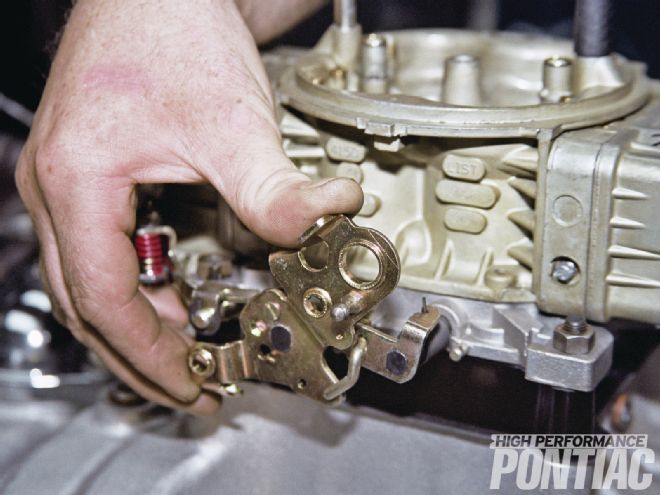 10 For a cranking compression test pin or hold the throttle wide open and have the coil wire grounded or primary lead removed.
10 For a cranking compression test pin or hold the throttle wide open and have the coil wire grounded or primary lead removed.
Analyzing the Results
When studying the data for your engine, the intended use must be recognized. For this reason, good data and a history are very important.
Any auto mechanic’s textbook will assume the engine is in a vehicle used as basic transportation. A car that is driven to cruise nights and such can run very well and still provide a good deal of service life with a 20 or 30 percent difference or more in cranking compression. If you are a racer, that is unacceptable. Our Mule only had a 5-psi (2 percent) difference between the lowest and highest cylinder. After all of the full-power runs it experienced, that is a real statement to RaceKrafter’s quality machine work, final assembly, and the piston rings used.
When it comes to running compression, the values will usually be lower than the cranking compression. This is due to the closed throttle at idle and the pumping losses experienced. You may also see more of a variation due to unequal volumetric efficiency from overlap of the camshaft and the design of the intake manifold. These areas all equalize as the engine speed increases.
For example, The Mule had only a 5-psi variation in cranking compression but a 15-psi difference while running. This was approximately a 12 percent differential versus a cranking difference of under 3 percent. The cranking compression is excellent. The running compression showed reversion from the camshaft and the variation of intake manifold runner length that is normal on a production-style induction path. This was impacting the cylinder pressure at idle in each bore. That is visual proof of the rumpty-rump sound that we all love to hear from a Pontiac with a performance camshaft.
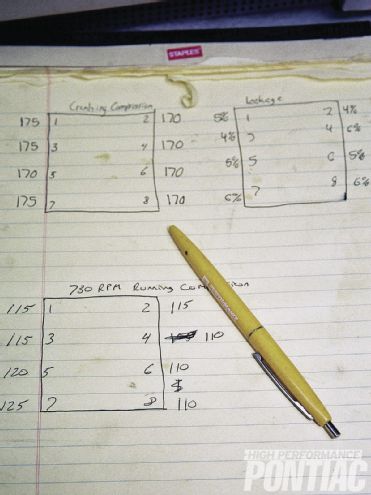 11 Take notes of all the results and file them with a date and mileage or other qualifier. This data will be very valuable to check the wear on your Pontiac engine as time goes by.
11 Take notes of all the results and file them with a date and mileage or other qualifier. This data will be very valuable to check the wear on your Pontiac engine as time goes by.
When it came to cylinder leakage, once again the quality of the engine came shining through. With it cold (forged pistons and poorer ring seal) the leakage was still only between 4 and 6 percent—an excellent figure for a street/strip engine and a good reading for an entry-level race engine. No serious race engine would have been together for more than 100 runs without being gone through. In that type of use you would normally see 2-3 percent leak. But then again the application is paramount.
A drag race engine in a top class with 6 percent leakage would be considered needing a re-ring, but the same value on a road race engine would be fine. In drag racing you look at everything in 0.001 second. Even a 5hp loss would be seen on the timeslip in a professional class. For a street motor, up to 15 percent leakage may or may not be acceptable.
The Mule is in excellent health with absolutely no signs of any wear and tear. We can now move forward in confidence with our testing. You can do the same with your Pontiac once you have all the numbers.
HPP Engine Buildup Worksheet
Engine Displacement: 467 ci
Bore/Stroke: 4.185 / 4.250-in
Bore/Stroke ratio: 0.98:1
Rod/Stroke ratio: 1.6:1
Bottom End
Block: Stock ’75 455
Deck height: 10.205-in
Crank: Butler/Eagle forged
Balancer: Summit Street/Strip, steel, elastomer, 6.610-in, SFI 18.1
Rods: Eagle forged H-beam, 6.800-in
Bearings: Clevite, plain shell, tri-metal
Pistons: Butler/Ross forged flat-top with valve reliefs
Piston-to-deck height: 0.010-in below
Piston pins: Ross, 0.990-in floating, 0.155-in wall
Method used to retain pins in pistons: Spiro Locks
Rings: Total Seal, moly top, ductile second, 3-piece oil, 1⁄16-, 1⁄16-, 3⁄16-in
Rod bolts and head bolts: ARP
Balancing specs: Internal
Oiling System
Windage tray: Canton in pan
Crank scraper: Canton in pan
Oil pan: Canton Racing Road Race Series 5-quart, wet-sump
Oil pump: Melling M54DS high-volume
Heads
Casting number: 6X
Combustion chamber volume: 96.2ccs
Maximum flow at 28 inches of pressure:
Lift Intake Flow CFM Exhaust Flow CFM 0.100 66 55 0.200 133 106 0.300 191 149 0.400 224 170 0.500 236 182 0.600 250 186
Compression ratio: 9.1:1
Valves: Manley SS 2.11/1.77-in
Angles used in valve job:
Intake 45, 60, 75, and 82-deg, 82 is hand-blended into 75-deg.
Exhaust 45-deg, 12mm radius
Retainers: Comp Cams, steel, 10-deg beehive
Keepers: Comp Cams 10-deg, 11⁄32-in
Valve Guides: K-line bronze liner
Valve Seals: Steel/Viton
Rocker Studs: ARP 7⁄16-in
Rocker Arms: Comp Cams aluminum full-roller, 1.65:1
Pushrods: Manley 3⁄8x8.900-in
Cam
Brand: Comp Cams Xtreme Energy hydraulic roller
Duration At 0.050: 224/230-deg
Lift: 0.552/0.561-in
Centerline: 106-deg
Lobe Separation Angle: 110-deg
Installed Position: 106-deg
Lifters: Comp Cams roller
Valvesprings: Comp Cams Beehive
Seat Pressure: 137 lb/in
Open Pressure: 290 lb/in
Timing Chain: Cloyes double-roller
Induction
Carb: Holley 4150 HP 750-cfm, mechanical secondaries
Intake Manifold: Edelbrock Torker II
Ignition
Distributor: MSD Pro-Billet Ready-to-Run
Wires: MSD 8.5mm
Exhaust
Headers: Hooker
Primary Tube Diameter: 1.75-in
Primary Tube Length: 32-in
Collector Size: 3.00-in
Gaskets
Brand: Fel Pro
Parts Sources
Engine Components: Summit Racing Equipment
Reciprocating Assembly: Butler Performance
Cranking Compression at
Approx.225-250 rpm
Cylinder
PSI
1
175
2
170
3
175
4
170
5
170
6
170
7
175
8
170
Running Compression
at 730 rpm
Cylinder
PSI
1
115
2
115
3
115
4
110
5
120
6
110
7
125
8
110
Leakdown With
100 psi of air applied
Cylinder
%
1
5%
2
4%
3
4%
4
6%
5
5%
6
5%
7
6%
8
6%